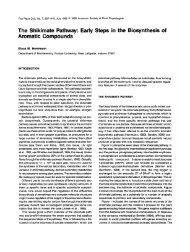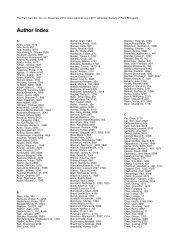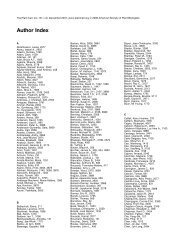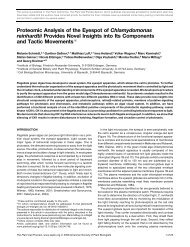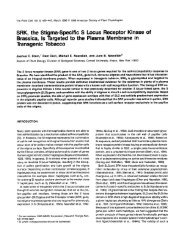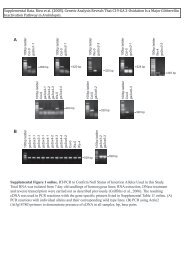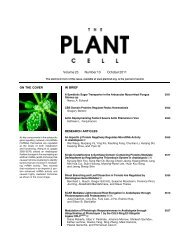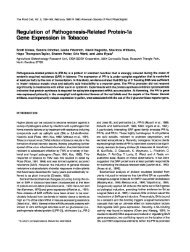PORA and PORB, Two Light-Dependent ... - The Plant Cell
PORA and PORB, Two Light-Dependent ... - The Plant Cell
PORA and PORB, Two Light-Dependent ... - The Plant Cell
- TAGS
- pora
- porb
- plant
- cell
- www.plantcell.org
Create successful ePaper yourself
Turn your PDF publications into a flip-book with our unique Google optimized e-Paper software.
<strong>The</strong> <strong>Plant</strong> <strong>Cell</strong>, Vol. 8, 763-769, May 1996 O 1996 American Society of <strong>Plant</strong> Physiologists<br />
REVIEW ARTICLE<br />
<strong>PORA</strong> <strong>and</strong> <strong>PORB</strong>, <strong>Two</strong> <strong>Light</strong>-<strong>Dependent</strong><br />
Protochlorophyllide-Reducing Enzymes of<br />
Angiosperm Chlorophyll Biosynthesis<br />
Steffen Reinbothe,ai’ Christiane Reinbothe,a Nikolai Lebedev,b <strong>and</strong> Klaus Apela<br />
a lnstitute for <strong>Plant</strong> Sciences, Department of Genetics, Swiss Federal lnstitute of Technology Zurich (ETH), ETH-Zentrum,<br />
Universitatsstrasse 2, CH-8092 Zurich, Switzerl<strong>and</strong><br />
A.N. Bakh lnstitute of Biochemistry, Russian Academy of Sciences, Leninsky pr 33, Moscow 117071, Russia<br />
INTRODUCTION<br />
Chloroplasts are the most abundant organelles in a plant cell.<br />
Besides their familiar roles in photosynthesis, chloroplasts<br />
also perform important functions during numerous other<br />
metabolic processes, such as nitrogen assimilation, amino<br />
acid biosynthesis, <strong>and</strong> tetrapyrrole production. ln particular,<br />
a major route of chloroplast anabolism is devoted to the syn-<br />
thesis of chlorophyll (Chl; von Wettstein et al., 1995). As the<br />
“pigment of life,” Chl plays a fundamental role in the energy<br />
absorption <strong>and</strong> transduction activities of all photosynthetic<br />
organisms (Bogorad, 1967; von Wettstein et al., 1971).<br />
In angiosperms, Chl synthesis is dependent on light<br />
(Granick, 1950). NADPH:protochlorophyllide oxidoreductase<br />
(POR; EC 1.3.1.33) catalyzes the only known light-requiring<br />
step of tetrapyrrole biosynthesis, the reduction of proto-<br />
chlorophyllide (Pchlide) to chlorophyllide (Chlide) (Griffiths,<br />
1978; Apel et al., 1980). Both the POR(A) enzyme <strong>and</strong> its<br />
substrate, Pchlide, accumulate to high levels in dark-grown<br />
plants. Together with NADPH, they form a ternary complex that<br />
instantaneously converts Pchlide to Chlide when illuminated.<br />
<strong>The</strong> operation of <strong>PORA</strong> hence helps prevent photodynamic<br />
damage by large amounts of not immediately photoconvert-<br />
ible Pchlide.<br />
<strong>The</strong> function of <strong>PORA</strong> is confined to the very early stages<br />
of transition from etiolated to light growth (Apel, 1981;<br />
Batschauer <strong>and</strong> Apel, 1984; Mosinger et al., 1985; Forreiter<br />
et al., 1990). <strong>The</strong> amounts of both <strong>PORA</strong> protein <strong>and</strong> porA<br />
mRNA decrease drastically soon after the beginning of illumi-<br />
nation (Mapleston <strong>and</strong> Griffiths, 1980; Santel <strong>and</strong> Apel, 1981;<br />
Forreiter et al., 1990), due in part to rapid proteolytic turnover<br />
of the enzyme protein (Kay <strong>and</strong> Griffiths, 1983; Hauser et al.,<br />
1984).<br />
To perform the reduction of Pchlide to Chlide during the fi-<br />
nal stages of the light-induced greening <strong>and</strong> to sustain Chl<br />
To whom correspondence should be addressed<br />
synthesis in mature leaves, a second Pchlide-reducing en-<br />
zyme has to operate in angiosperms. This enzyme, termed<br />
<strong>PORB</strong>, is active under all tested conditions <strong>and</strong> drives Chlide<br />
synthesis particularly in green plants (Holtorf et al., 1995). This<br />
review summarizes our current knowledge of the different<br />
POR enzymes in angiosperms, their differential expression<br />
in response to light, <strong>and</strong> their putative roles in Chl biosynthe-<br />
sis <strong>and</strong> chloroplast development.<br />
<strong>PORA</strong>-THE SHORT LlFETlME OF AN<br />
EXTRAORDINARY ENZYME<br />
<strong>PORA</strong>-A “Suicidal” Enzyme?<br />
In higher plants, the synthesis <strong>and</strong> assembly of Chl (used to<br />
refer collectively to Chls a <strong>and</strong> b) into the two photosyntheti-<br />
cally active thylakoid membrane complexes are regulated by<br />
light (Bogorad, 1967; von Wettstein et al., 1971, 1995). Chl is<br />
controlled at multiple levels in both the nucleocytoplasmic <strong>and</strong><br />
plastid compartments <strong>and</strong> includes processes such as tran-<br />
scription, post-transcriptional RNA processing <strong>and</strong> modification,<br />
<strong>and</strong> post-translational protein import <strong>and</strong> protein stabilization<br />
(van Grinsven <strong>and</strong> Kool, 1988; Thompson <strong>and</strong> White, 1991).<br />
<strong>The</strong> establishment of the photosynthetic apparatus during the<br />
transition from dark (etiolated) to light growth leads to the visi-<br />
ble greening of the plant (Thorne, 1971). During this process,<br />
etioplasts differentiate into chloroplasts (Virgin et al., 1963;<br />
Henningsen, 1970; Kirk <strong>and</strong> Tilney-Basset, 1978). Simultane-<br />
ously, leaf development proceeds (Mullet, 1988).<br />
When angiosperm seedlings are grown in darkness, plastid<br />
development is arrested at an early stage, giving rise to the<br />
etioplast (Virgin et al., 1963). Within this organelle, the prolamel-<br />
lar body forms a paracrystalline structure (Virgin et al., 1963;<br />
Henningsen, 1970) composed of lipids <strong>and</strong> proteins (HByer-<br />
Hansen <strong>and</strong> Simpson, 1977). Among these macromolecules,
764 <strong>The</strong> <strong>Plant</strong> <strong>Cell</strong><br />
the one protein that predominares is <strong>PORA</strong> (Ikeuchi <strong>and</strong><br />
Murakami, 1983; Dehesh <strong>and</strong> Ryberg, 1985). Together with<br />
its two substrates, Pchlide <strong>and</strong> NADPH, <strong>PORA</strong> forms a ternary<br />
complex (Griffiths, 1978; Apel et al., 1980). When<br />
illuminated, <strong>PORA</strong> photoreduces its Pchlide to Chlide (Griffiths,<br />
1978; Apel et al., 1980; Mapleston <strong>and</strong> Griffiths, 1980; Santel<br />
<strong>and</strong> Apel, 1981), <strong>and</strong> simultaneously, the prolamellar body begins<br />
to disintegrate (Virgin et al., 1963; Henningsen, 1970).<br />
During catalysis, <strong>PORA</strong> is inactivated <strong>and</strong> subsequently<br />
degraded (Santel <strong>and</strong> Apel, 1981; Kay <strong>and</strong> Griffiths, 1983;<br />
Hauser et al., 1984; Forreiter et al., 1990).<br />
Attracted by the extraordinary behavior of <strong>PORA</strong>- its requirement<br />
for but also its sensitivity to light-scientists have made<br />
great effort to purify this protein <strong>and</strong> to characterize its catalytic<br />
properties (summarized in Schulz <strong>and</strong> Senger, 1993).<br />
<strong>The</strong>se studies were reinforced by the recent cloning of POR<br />
cDNAs from both angiosperms, such as barley (Schulz et al.,<br />
1989; Holtorf et al., 1995), wheat (Teakle <strong>and</strong> Griffiths, 1993),<br />
oat (Darrah et al., 1990), pea (Spano et al., 1992a), <strong>and</strong><br />
Arabidopsis (Benli et al., 1991; Armstrong et al., 1995), <strong>and</strong><br />
gymnosperms, such as pine (Spano et al., 1992b; Forreiter<br />
<strong>and</strong> Apel, 1993), as well as from cyanobacteria, such as Synechocysfis<br />
sp strain PCC 6803 (Suzuki <strong>and</strong> Bauer, 1995).<br />
<strong>The</strong> reaction catalyzed by POR is a ffans-reduction of the<br />
double bond in ring D of the tetrapyrrole ring system (Begley<br />
<strong>and</strong> Young, 1989), as shown in Figure 1. This reaction requires<br />
NADPH as cosubstrate as well as light (Griffiths, 1978; Apel<br />
et al., 1980; Santel <strong>and</strong> Apel, 1981). During catalysis, POR first<br />
binds NADPH, then Pchlide. A ternary POR-Pchlide-NADPH<br />
complex is formed. This complex is spectroscopically detectable<br />
(Figure 2, P~hlide~~~-~~~<br />
nm) in prolamellar bodies of<br />
wheat <strong>and</strong> barley etioplasts (Griffiths, 1978; Oliver <strong>and</strong> Griffiths,<br />
1982) <strong>and</strong> in greening barley leaves (Franck <strong>and</strong> Strzalka,<br />
1992), <strong>and</strong> can also be reconstituted in vitro either with<br />
detergent-solubilized enzymes, such as those from wheat or<br />
barley etioplasts (Griffiths, 1978; Apel et al., 1980; Santel <strong>and</strong><br />
Apel, 1981; Oliver <strong>and</strong> Griffiths, 1982; Schoch et al., 1995),<br />
or with the cDNA-encoded, in vitro-synthesized <strong>PORA</strong> precur-<br />
NADPH, <strong>Light</strong><br />
POR<br />
PrOlochiomphyllide Chloiophyliide<br />
Figure 1. <strong>The</strong> Reaction Catalyzed by POR<br />
POR catalyzes the only known light-requiring step of tetrapyrrole bio-<br />
synthesis, the NADPH-dependent trans-reduction of the double bond<br />
in ring D of Pchlide to Chlide.<br />
POR : NADPH : Pchlide<br />
Pchlide (650-657)<br />
i 6 2 8 - 6 3 2 ) Y<br />
POR : NADPH<br />
Chlide<br />
(672-680)<br />
POR : NADP' : Chlide<br />
(678-690)<br />
POR : NADPH : Chlide NADP+<br />
(684-696)<br />
I b,<br />
Degradation<br />
Figure 2. Steps in the Reaction Mechanism Catalyzed by POR.<br />
During POR-driven Pchlide reduction to Chlide, several intermediate<br />
steps can be distinguished spectroscopically. Although the <strong>PORA</strong> en-<br />
zyme appears to be used repeatedly for catalysis in etiolated plants<br />
at the very beginning of illumination (route a), a light-induced protease<br />
degrades freshly formed <strong>PORA</strong>-NADPH-Chlide complexes in etio-<br />
chloroplasts <strong>and</strong> also in chloroplasts (route b).<br />
sor protein of barley (Holtorf et al., 1995; Reinbothe et al.,<br />
1995a, 1995b).<br />
Based on sequence comparison with other proteins found<br />
in the data banks, it has been proposed (Wilks <strong>and</strong> Timko, 1995)<br />
that NADPH binds to a region of the POR polypeptide that is<br />
similar to that of short-chain alcohol dehydrogenases (Baker,<br />
1994). Active site residues in the pea enzyme, such as Tyr-<br />
225 <strong>and</strong> Lys-279, are involved in NADPH binding (Wilks <strong>and</strong><br />
Timko, 1995), whereas two or even three of the evolutionarily<br />
conserved cysteine residues have been implicated as participating<br />
in Pchlide binding <strong>and</strong>/or catalysis (Oliver <strong>and</strong> Griffiths,<br />
1981; Dehesh et al., 1986; Teakle <strong>and</strong> Griffiths, 1993). Dueto<br />
the presence of the tetrapyrrole ring system, the ternary<br />
POR-Pchlide-NADPH complex is able to absorb light, in particular<br />
blue light, <strong>and</strong> thus is photoactive (summarized in<br />
Ryberg <strong>and</strong> Sundqvist, 1991).<br />
<strong>Light</strong> absorption sets in motion a series of spectral changes<br />
that reflect individual steps in enzyme catalysis, as shown in<br />
Figure 2 (Oliver <strong>and</strong> Griffiths, 1981; Franck <strong>and</strong> Strzalka, 1992).<br />
In contrast to NADP+, which is rapidly displaced by fresh<br />
NADPH, Chlide appears to remain bound to the POR polypeptide<br />
in vivo. Its release is a relatively slow process, as seen<br />
by the Shibata shift (Shibata, 1957), that is, a spectral change<br />
Of chlide684-696 nm to Chlides72-680 nm (Figure 2). It was SUggested<br />
that after the reiease of Chlide, a new molecule of<br />
Pchlide binds to the POR-NADPH complex to re-form the photoactive<br />
ternary complex (Figure 2, route a; Oliver <strong>and</strong> Griffiths,<br />
1982). By proceeding repeatedly through this cycle of substrate<br />
binding, product formation, <strong>and</strong> product release, POR has been<br />
proposed to be used several times for catalysis (Oliver <strong>and</strong><br />
Griffiths, 1982), as expected for an ordinary enzyme.<br />
Recent results obtained for the cDNA-encoded <strong>PORA</strong> protein<br />
of barley do not appear to support this explanation.
Chlorophyllide is not easily dissociated from the enzyme<br />
(Reinbothe et al., 1995b). Rather, the pigment remains tightly<br />
bound to <strong>PORA</strong> <strong>and</strong> can be released only by denaturation,<br />
such as heating or treatment with SDS (Reinbothe et al.,<br />
1995b), suggesting that each <strong>PORA</strong> molecule may be used<br />
for catalysis only once. Hence, <strong>PORA</strong> might be regarded as<br />
a suicida1 enzyme.<br />
In contrast to this view, Nielsen (1974, 1975) has provided<br />
evidence that Pchlide may replace Chlide from the substrate<br />
",) exists, Chlide does not leave the enzyme,<br />
but it can do so if free Pchlide is produced by feeding the pig-<br />
ment precursor 5-aminolevulinic acid. Similarly, excess Pchlide<br />
that accumulates in the dark in the figrina 034 mutant of bar-<br />
ley can be successively converted to Chlide by short light<br />
flashes'at 6 to 10°C (Nielsen, 1974). Because there is a pool<br />
of photoinactive Pchlide also in wild-type etioplasts that can<br />
replace Chlide from the <strong>PORA</strong> enzyme, one may conclude<br />
that <strong>PORA</strong>, at least during the transition from dark to light<br />
growth, can be used severa1 times for subsequent rounds of<br />
catalysis.<br />
Proteolytic Degradation of <strong>PORA</strong><br />
Pioneering studies with POR(A) have suggested that photocon-<br />
version of Pchlide <strong>and</strong> transformation of the prolamellar body<br />
may represent a single photodependent process (Kahn, 1968).<br />
Re-formation of POR(A)-Pchlide-NADPH complexes, which<br />
would stabilize the prolamellar body, thus does not seem to<br />
occur in vivo. Instead, proteolytic degradation of the POR(A)-<br />
Chlide complex(Figure2, route b) maycontribute to the disin-<br />
tegration of the prolamellar body. In line with this possibility,<br />
<strong>PORA</strong>-Chlide complexes were found to be highly suscepti-<br />
ble to degradation by plastid proteases in vitro <strong>and</strong> in organello,<br />
whereas <strong>PORA</strong>-substrate complexes, such as <strong>PORA</strong>-Pchlide<br />
or <strong>PORA</strong>-Pchlide-NADPH, were protease resistant (Reinbothe<br />
et al., 1995; Reinbothe et al., 1995~).<br />
Although these findings may imply an involvement of pro-<br />
teolysis in the breakdown of the prolamellar body, there is one<br />
important argument against this possibility. <strong>The</strong> protease ac-<br />
tivity that degrades POR is not active in etioplasts (Reinbothe<br />
et al., 1995; Reinbothe et al., 199%). As a nuclear gene prod-<br />
uct, it appears in the light (Reinbothe et al., 1995; Reinbothe<br />
et al., 1995c) <strong>and</strong> reaches its final activity only when the disin-<br />
tegration of the prolamellar body has been completed (Virgin<br />
et al., 1963; Henningsen, 1970). Despite this fact, it has been<br />
speculated that the proteolytic degradation of <strong>PORA</strong> can have<br />
an important physiological meaning in vivo (Kay <strong>and</strong> Griffiths,<br />
1983; Hauser et al., 1984). Proteolytic fragments of <strong>PORA</strong>, such<br />
as those generated in vitro (Reinbothe et al., 1995), can serve<br />
as vehicles for the transfer of freshly formed Chlide to the de-<br />
veloging thylakoids. 60th nuclear- <strong>and</strong> plastid-encoded Chl<br />
binding proteins are stable only in the presence of their pig-<br />
Spotlight on POR Function 765<br />
ments (Apel <strong>and</strong> Kloppstech, 1980; Bennett, 1981; Kim et al.,<br />
1994). It might also be that such Chlide-containing peptides<br />
of <strong>PORA</strong> can regulate the whole assembly pathway of the pho-<br />
tosynthetically active thylakoid membrane complexes. In<br />
particular, synthesis of the plastid-encoded Chl binding pro-<br />
teins has been suggested to be regulated cotranslationally (for<br />
a critical discussion, see Kim et al., 1994).<br />
To accomplish its role in the buildup of the photosynthetic apparatus<br />
during the very early stages of transition from etiolated<br />
to light growth, <strong>PORA</strong> would have to interact with Pchlide <strong>and</strong><br />
photoreduce the pigment within the prolamellar body close<br />
to the developing thylakoids. Interestingly, plastids solve this<br />
problem by coupling the import of the cytosolic precursor of<br />
<strong>PORA</strong> (p<strong>PORA</strong>) to the supply of Pchlide (Reinbothe et al.,<br />
1995a, 1995b).<br />
In vitro import studies performed with the radioactively labeled<br />
<strong>PORA</strong> precursor polypeptide of barley synthesized by<br />
coupled transcriptionhranslation of a porkspecific cDNA (Schulz<br />
et al., 1989) <strong>and</strong> isolated plastids show that etioplasts efficiently<br />
sequester p<strong>PORA</strong> (Figure 3). Pchlide inside the etioplasts is<br />
required for the import of the p<strong>PORA</strong> <strong>and</strong> its processing to<br />
mature size. During the step of precursor translocation, p<strong>PORA</strong><br />
binds Pchlide; then the transit peptide is removed, followed<br />
by targeting of the ternary <strong>PORA</strong>-Pchlide-NADPH complex<br />
to the prolamellar body (Reinbothe et al., 1995a).<br />
Soon after the beginning of illumination, the leve1 of Pchlide<br />
declines drastically (Sundqvist, 1974; Mapleston <strong>and</strong> Griffiths,<br />
1980), <strong>and</strong> the developing etiochloroplasts lose their capability<br />
to sequester p<strong>PORA</strong>(Reinbothe et al., 1995a, 1995~). Due<br />
to the depletion in the pool of translocation-active Pchlide, chloroplasts<br />
can no longer import p<strong>PORA</strong> (Figure 3). However, they<br />
still can import other precursor proteins, such as the precursor<br />
of the small subunit of ribulose-l,5-bisphosphate carboxylase/oxygenase<br />
<strong>and</strong> a dihydrofolate reductase reporter protein<br />
of mouse fused to the transit peptide of plastocyanin of Silene<br />
prafensis (Reinbothe et al., 1995a). When such chloroplasts<br />
are supplied with Pchlide, for example, by incubating the organelles<br />
with 5-aminolevulinic acid, a precursor of Pchlide,<br />
their import capacity for p<strong>PORA</strong> can be restored (Figure 3).<br />
Similarly, mutants of barley that are defective in the regulation<br />
of chlorophyll biosynthesis, such as the figrina mutants (summarized<br />
in Henningsen et al., 1993), import p<strong>PORA</strong> under<br />
conditions that lead to excess plastidic Pchlide accumulation<br />
(Reinbothe et al., 1995~).<br />
In wild-type barley plants grown in dark <strong>and</strong> light cycles, the<br />
transport competence of the chloroplasts for p<strong>PORA</strong> is at a<br />
minimum during the last hours of the day, when Pchlide levels<br />
are low, but is considerable at the end of the night, when<br />
Pchlide has accumulated substantially (Reinbothe et al.,<br />
1995a). Hence, one can conclude that the Pchlide-dependent<br />
plastid import pathway of the p<strong>PORA</strong> still remains operative
766 <strong>The</strong> <strong>Plant</strong> <strong>Cell</strong><br />
pPOR<br />
POR<br />
EP<br />
bed<br />
ECP<br />
a b e d<br />
CP<br />
abed<br />
- I<br />
Figure 3. <strong>The</strong> Substrate Dependency of p<strong>PORA</strong>'s Plastid Import.<br />
Barley etioplasts (EP), etiochloroplasts (ECP), <strong>and</strong> chloroplasts (CP)<br />
were isolated from etiolated seedlings, dark-grown seedlings that had<br />
been exposed to light for 30 min, <strong>and</strong> light-grown seedlings, respectively.<br />
Each of the various plastid samples was then divided into two<br />
equal parts. One half was incubated with 5-aminolevulinic acid (0.5<br />
mM final concentration); the other half was incubated with phosphate<br />
buffer alone instead of 5-aminolevulinic acid. <strong>The</strong> different plastids<br />
were then incubated with the radioactively labeled p<strong>PORA</strong> of barley<br />
synthesized by coupled in vitro transcription/translation of the porAspecific<br />
cDNA clone A7 (Schulz et al., 1989) in the dark for 15 min.<br />
35 S-methionine-labeled p<strong>PORA</strong> (pPOR) molecules that had not been<br />
sequestered by the plastids <strong>and</strong> thus remained in the supernatant after<br />
centrifugation of the assays were precipitated with trichloroacetic<br />
acid, separated electrophoretically, <strong>and</strong> detected by autoradiography<br />
(top). Similarly, the mature radiolabeled <strong>PORA</strong> (POR) was recovered<br />
from thermolysin-treated, intact plastids by sonication <strong>and</strong> precipitation<br />
with trichloroacetic acid <strong>and</strong> was run in a separate denaturing<br />
polyacrylamide gradient <strong>and</strong> detected by autoradiography (bottom).<br />
Shown are the levels of the 44-kD p<strong>PORA</strong> <strong>and</strong> 36-kD <strong>PORA</strong>, each<br />
before (lanes a <strong>and</strong> c) <strong>and</strong> after (lanes b <strong>and</strong> d) incubation with plastids<br />
containing (lanes a <strong>and</strong> b each) or lacking (lanes c <strong>and</strong> d each) the<br />
exogenous 5-aminolevulinic acid-derived Pchlide. Note that etioplasts<br />
<strong>and</strong> etiochloroplasts, due to their high endogenous level of Pchlide,<br />
sequester p<strong>PORA</strong> in the absence of additional Pchlide produced by<br />
5-aminolevulinic acid feeding. By contrast, chloroplasts, which lack<br />
translocation-active Pchlide, can import p<strong>PORA</strong> only when their endogenous<br />
level of Pchlide is raised by 5-aminolevulinic acid feeding.<br />
in chloroplasts. This conclusion is valid not only for barley but<br />
also for chloroplasts from pea, wheat, <strong>and</strong> Arabidopsis (C.<br />
Reinbothe, S. Reinbothe, <strong>and</strong> K. Apel, unpublished data).<br />
Further evidence for operation of the Pchlide-dependent<br />
plastid import pathway of the p<strong>PORA</strong> in vivo is provided by<br />
protein gel blot analyses that demonstrate the presence of a<br />
44-kD protein among plastid proteins of barley seedlings that<br />
had been exposed to light for 8 hr (S. Reinbothe, C. Reinbothe,<br />
D. Neumann, <strong>and</strong> K. Apel, submitted manuscript). This 44-kD<br />
protein is likely to represent p<strong>PORA</strong> that, due to the depletion<br />
in the pool of translocation-active Pchlide within the etiochloroplasts,<br />
accumulates at the outer plastid envelope. When<br />
Pchlide formation is induced by feeding the plastids 5-aminolevulinic<br />
acid, p<strong>PORA</strong> is chased into the organelles, processed<br />
to mature size, <strong>and</strong> targeted to the thylakoids.<br />
Remarkably, the <strong>PORA</strong> also can be released from the plastid<br />
envelope if Pchlide is supplied from the outside of the etiochloroplasts.<br />
However, this substrate-induced release of<br />
p<strong>PORA</strong> was not observed in the presence of a cytosolic 70kD<br />
heat shock cognate protein (Hsc70) that is contained in<br />
wheat germ extracts added to the incubation mixtures. By analogy<br />
with other members of the chaperonin family, the cytosolic<br />
Hsc70 appears to stabilize a transport-competent conformation<br />
of the envelope-bound p<strong>PORA</strong>.<br />
When enzymatic Chlide formation was induced by incubating<br />
the in vitro-synthesized p<strong>PORA</strong> with Pchlide <strong>and</strong> NADPH<br />
in the light before import, the ATP-dependent binding of the<br />
precursor protein to the chloroplasts was abolished (Reinbothe<br />
etal., 1995b). In vitro processing experiments with leader peptidase<br />
preparations further demonstrated that Chlide causes<br />
a conformational change through which the transit peptide of<br />
the p<strong>PORA</strong> is rendered inaccessible to interact with the plastid<br />
envelope (Reinbothe et al., 1995b). Hence, Hsc70 does not<br />
seem able to denature the tightly folded p<strong>PORA</strong>-Chlide complex<br />
in vitro. Unfolding of p<strong>PORA</strong> is likely to occur not before<br />
but rather during its translocation (Reinbothe et al., 1995b).<br />
<strong>The</strong> actual driving forces for translocation appear to be ATP<br />
<strong>and</strong> the interaction between intraplastidic Pchlide <strong>and</strong> p<strong>PORA</strong>.<br />
We assume that there are three binding sites for Pchlide in<br />
p<strong>PORA</strong>: one in the transit peptide <strong>and</strong> two in the mature part<br />
of the protein. Alternative binding of Pchlide to these three pigment<br />
binding sites appears to determine the direction in which<br />
the unfolded precursor will move.<br />
<strong>The</strong> Pchlide-dependent import of the precursor into the<br />
plastids appears to be devoted to the specific task of supplying<br />
the prolamellar body with both <strong>PORA</strong> <strong>and</strong> Pchlide. In<br />
addition, the operation of this import pathway has been proposed<br />
to be part of a protective mechanism through which<br />
plants lower the risk that excited Pchlide molecules will cause<br />
photooxidation of the plastid compartment during the very early<br />
stages of transition from etiolated to light growth (Reinbothe<br />
et al., 1995a, 1995b). By contrast, the physiological significance<br />
of the exogenous Pchlide-induced release of the envelopebound<br />
p<strong>PORA</strong> to the cytosol is as yet undetermined. It is<br />
conceivable, however, that it might be part of a regulatory mechanism<br />
through which nuclear gene expression can be<br />
controlled by tetrapyrrole signals that are liberated from the<br />
plastid.<br />
<strong>Light</strong>-Depressed porA Gene Transcription<br />
<strong>The</strong> rapid degradation of <strong>PORA</strong>-Chlide complexes <strong>and</strong> the<br />
impairment of p<strong>PORA</strong>'s plastid import appear to be only two<br />
of three mechanisms through which plants confine the function<br />
of <strong>PORA</strong> to the very early stages of the light-induced<br />
greening. <strong>The</strong> third level of control is that of porA gene transcription.<br />
<strong>The</strong> port gene is active only in etiolated seedlings,<br />
but its transcription declines soon after the beginning of illumination<br />
(Apel, 1981; Batschauer <strong>and</strong> Apel, 1984; Mosinger
et al., 1985; Forreiter et al., 1990). Phytochrome, presumably<br />
the phytochrome A holocomplex, is responsible for porA gene<br />
inactivation (Batschauer <strong>and</strong> Apel, 1984; Mosinger et al., 1985).<br />
Conditions that favor the formation of the active phytochrome<br />
holocomplex, such as far-red light treatment, lead to a drastic<br />
reduction in porA gene transcription <strong>and</strong> porA transcript abun-<br />
dance (Batschauer <strong>and</strong> Apel, 1984; Mosinger et al., 1985).<br />
In constitutive morphogenetic mutants of Arabidopsis, in<br />
which certain steps in the signal transduction pathway of<br />
phytochrome action are already active in the dark, such as<br />
in the deetiolated 1 (detl; Chory et al., 1989), constitutive pho-<br />
tomorphogenetic 9 (cop9; Wei <strong>and</strong> Deng, 1992), or det340<br />
(Lebedev et al., 1995) mutants, noporA transcript was detected<br />
(Lebedev et al., 1995). Prolamellar bodies comparable to those<br />
in etiolated wild-type seedlings are lacking (Chory et al., 1989;<br />
Lebedev et al., 1995) or structurally impaired (Wei <strong>and</strong> Deng,<br />
1992), <strong>PORA</strong> is absent, <strong>and</strong> normal greening, despite the pres-<br />
ente of the nuclear- <strong>and</strong> plastid-encoded light-harvesting Chl<br />
binding protein transcripts (Chory et al., 1989; Wei <strong>and</strong> Deng,<br />
1992), is delayed (Lebedev et al., 1995). To pose theporA gene<br />
under the control of phytochrome thus appears to have a strong<br />
impact on the control of plastid development both in the dark<br />
<strong>and</strong> in the light.<br />
<strong>PORB</strong>-THE "TRUE Pchlide-REDUCING ENZYME<br />
Even though <strong>PORA</strong>'s role in etioplast-to-chloroplast differentiation<br />
appears to be multivalent, its function during Chl synthesis<br />
in green plants is limited. Dueto the cumulative effect of light<br />
on the expression of the porA gene, on the plastid import of<br />
the cytosolic precursor protein, <strong>and</strong> on the stability of the imported<br />
enzyme, <strong>PORA</strong> disappears from illuminated seedlings<br />
long before Chl accumulation has reached its maximum rate.<br />
Thus, another Pchlide-reducing enzyme must exist that drives<br />
Chl synthesis in the absence of <strong>PORA</strong>. Particularly in green<br />
plants, there is a continuous need to replace those pigment<br />
molecules that become damaged during light trapping <strong>and</strong><br />
energy transduction (see, e.g., De Las Rivas et al., 1993).<br />
<strong>The</strong> recently discovered <strong>PORB</strong> (Holtorf et al., 1995) in fact<br />
is a likely c<strong>and</strong>idate for a Pchlide-reducing enzyme that is operative<br />
in green plants. <strong>PORB</strong> is closely related to <strong>PORA</strong> in its<br />
predicted amino acid sequence as well as in its catalytic properties<br />
as a light- <strong>and</strong> NADPH-dependent enzyme (Holtorf et<br />
al., 1995). <strong>The</strong>por6 gene is active both in the dark <strong>and</strong> in the<br />
light <strong>and</strong> does not respond to phytochrome (Holtorf et al., 1995).<br />
Both por6 mRNA <strong>and</strong> <strong>PORB</strong> protein accumulate in etiolated,<br />
illuminated, <strong>and</strong> light-adapted plants (Holtorf et al., 1995).<br />
Although the plastid import pathway of <strong>PORB</strong> does not require<br />
Pchlide, <strong>PORB</strong> is still able to interact with the pigment<br />
(Reinbothe et al., 1995~). <strong>PORB</strong> imported into chloroplasts in<br />
vitro is stable in the dark, demonstrating its binding to Pchlide<br />
<strong>and</strong> NADPH, but its leve1 declines within a few minutes of illumination<br />
(Reinbothe et al., 1995~).<br />
Spotlight on POR Function 767<br />
<strong>Light</strong>-driven enzymatic product formation destines <strong>PORB</strong><br />
for degradation by plastid proteases. In vivo, pronounced fluc-<br />
tuations in <strong>PORB</strong> protein levels must thus be expected to occur<br />
in seedlings grown under alternating dark <strong>and</strong> light cycles, that<br />
is, under conditions reflecting those in nature. However, such<br />
oscillations have not been observed in previous experiments<br />
(Holtorf et al., 1995). Oscillations in porB mRNA concentra-<br />
tion with a maximum during the day <strong>and</strong> a minimum during<br />
the night appear to compensate for the preferential loss of<br />
<strong>PORB</strong> in the light (Holtorf et al., 1995). Changes in the activity<br />
of the POR-degrading protease seem also to modulate the ac-<br />
tua1 <strong>PORB</strong> enzyme concentration. Dueto its ATP requirement<br />
<strong>and</strong> pH optimum at pH 6.5 (Reinbothe et al., 1995), the POR-<br />
degrading protease is expected to be most active in the early<br />
hours of the day (before maximal levels of porB mRNA drive<br />
full <strong>PORB</strong> protein synthesis) but apparently would be inactive<br />
throughout the early night.<br />
CONCLUSIONS AND PERSPECTIVES<br />
<strong>The</strong> results reviewed in this article show that Chl synthesis<br />
in angiosperms is controlled by two different light-dependent<br />
POR enzymes. Both <strong>PORA</strong> <strong>and</strong> <strong>PORB</strong> are light- <strong>and</strong> NADPH-<br />
dependent Pchlide-reducing enzymes. As nuclear gene<br />
products, the cytosolic precursors of <strong>PORA</strong> <strong>and</strong> <strong>PORB</strong> are<br />
transported post-translationally into the plastids. Although the<br />
translocation of p<strong>PORA</strong> requires Pchlide, that of p<strong>PORB</strong> does<br />
not. Etioplasts containing translocation-active Pchlide can im-<br />
port p<strong>PORA</strong>, but chloroplasts cannot. However, both plastid<br />
types can sequester equally well p<strong>PORB</strong> <strong>and</strong> other cytosolic<br />
precursor proteins.<br />
Based on sequence comparison, we postulate that the differ-<br />
ence in the plastid import pathways of p<strong>PORA</strong> <strong>and</strong> pPOR6<br />
could be due to the existence of a Pchlide binding site in<br />
p<strong>PORA</strong>'s transit peptide. This pigment binding domain could<br />
interact with Pchlide that is formed in the plastid envelope<br />
(Pineau et al., 1986, 1993). Pchlide binding to p<strong>PORA</strong>'s transit<br />
peptide would thus induce the translocation step. However,<br />
dueto the postulated lack of such a pigment binding domain<br />
in its transit peptide, pPOR6 would be imported into the plastids<br />
in a Pchlide-independent manner.<br />
In addition to these differences in protein translocation across<br />
the plastid envelope, <strong>PORA</strong> <strong>and</strong> <strong>PORB</strong> are also distinct in their<br />
expression patterns. Although theporA gene is active only tran-<br />
siently in etiolated seedlings at the beginning of illumination,<br />
the por6 gene is operative also in green plants. This implies<br />
that the porA <strong>and</strong> por6 genes may contain different cis-<br />
regulatory elements in their promoters.<br />
Studies with transgenic plants to investigate the actual func-<br />
tions of <strong>PORA</strong> <strong>and</strong> <strong>PORB</strong> are very appealing. In particular,<br />
mutants expressing virtually no porA mRNA, such as porA<br />
gene-deficient mutants or mutants that mimic the presence<br />
of the functional phytochrome holocomplex, could be used as
768 <strong>The</strong> <strong>Plant</strong> <strong>Cell</strong><br />
a background for functional complementation <strong>and</strong> to study the<br />
role of the p<strong>PORA</strong> for Chl biosynthesis <strong>and</strong> chloroplast development.<br />
In particular, this approach could be exploited to<br />
investigate the effects of engineered mutations on <strong>PORA</strong> protein<br />
function.<br />
ACKNOWLEDGMENTS<br />
We are grateful to members of the group, in particular to Dieter Rubli<br />
<strong>and</strong> Barbara van Cleve, for their help in preparing the figures.<br />
Received November 10, 1995; accepted March 11, 1996<br />
REFERENCES<br />
Apel, K. (1981). <strong>The</strong> protochlorophyllide holochrome of barley (Hor-<br />
deum vulgare L.). Phytochrome-induced decrease of translatable<br />
mRNA coding for the NADPH:protochlorophyllide oxidoreductase.<br />
Eur. J. Biochem. 120, 89-93.<br />
Apel, K., <strong>and</strong> Kloppstech, K. (1980). <strong>The</strong> effect of light on the bio-<br />
synthesis of the light-harvesting chlorophyll alb protein. Evidence<br />
for the requirement of chlorophyll a for the stabilization of the<br />
apoprotein. <strong>Plant</strong>a 150, 426-430.<br />
Apel, K., Santel, H.-J., Redlinger, T.E., <strong>and</strong> Falk, H. (1980). <strong>The</strong> protochlorophyllide<br />
holochrome of barley. lsolation <strong>and</strong> characterization<br />
of the NADPH:protochlorophyllide oxidoreductase. Eur. J. Biochem.<br />
111, 251-258.<br />
Armstrong, G.A., Runge, S., Frick, G., Sperling, U., <strong>and</strong> Apel, K.<br />
(1995). ldentification of protochlorophyllide oxidoreductases A <strong>and</strong><br />
B: A branched pathway for light-dependent chlorophyll biosynthe-<br />
sis in Arabidopsis thaliana. <strong>Plant</strong> Physiol. 108, 1505-1517.<br />
Baker, M.E. (1994). Protochlorophyllide oxidoreductase is homologous<br />
to human carbonyl reductase <strong>and</strong> pig 20P-hydroxysteroid de-<br />
hydrogenase. Biochem. J. 300, 605-607.<br />
Batschauer, A., <strong>and</strong> Apel, K. (1984). An inverse control by phytochrome<br />
of the expression of two nuclear genes in barley. Eur. J. Biochem.<br />
143, 593-597.<br />
Begley, T., <strong>and</strong> Young, H. (1989). Protochlorophyllide reductase. 1.<br />
Determination of the regiochemistry <strong>and</strong> the stereochemistry of the<br />
reduction of protochlorophyllide to chlorophyllide. J. Am. Chem. SOC.<br />
11 1, 3095-3096.<br />
Benli, M., Schulz, R., <strong>and</strong> Apel, K. (1991). Effect of light on the NADPH-<br />
protochlorophyllide oxidoreductase of Arabidopsis thaliana. <strong>Plant</strong><br />
MOI. Biol. 16, 615-625.<br />
Bennett, J. (1981). Biosynthesis of the light-harvesting chlorophyll alb-<br />
protein. Polypeptide turnover in darkness. Eur. J. Biochem. 118,61-70.<br />
Bogorad, L. (1967). Biochemistry of chloroplasts. In Biosynthesis <strong>and</strong><br />
Morphogenesis in <strong>Plant</strong>s, T.W. Goodwin, ed (New York: Academic<br />
Press), pp. 615-631.<br />
Chory, J., Peto, C., Feinbaum, R., Pratt, L., <strong>and</strong> Ausubel, F. (1989).<br />
Arabidopsis thaliana mutant that develops as a light-grown plant in<br />
the absence of light. <strong>Cell</strong> 58, 991-999.<br />
Darrah, EM., Kay, S.A., Teakle, J.R., <strong>and</strong> Griffiths, W.T. (1990). Cloning<br />
<strong>and</strong> sequencing of protochlorophyllide reductase. Biochem. J.<br />
265, 789-798.<br />
Dehesh, K., <strong>and</strong> Ryberg, M. (1985). <strong>The</strong> NADPH-protochlorophyllide<br />
oxidoreductase is the major protein constituent of prolamellar bod-<br />
ies in wheat (7iiticum aestivum L.). <strong>Plant</strong>a 164, 396-399.<br />
Dehesh, K., Klaas, M., Hauser, I., <strong>and</strong> Apel, K. (1986). <strong>Light</strong>induced<br />
changes in the distribution of the 36000-Mrpolypeptide of<br />
NADPH-protochlorophyllide oxidoreductase within different cellular<br />
compartments of barley (Hordeum vulgare L.). I. Localisation by<br />
immunoblotting in isolated plastids <strong>and</strong> total leaf extracts. <strong>Plant</strong>a<br />
169, 162-171.<br />
De Las Rivas, J.D.L., Shipton, C., Ponticos, M., <strong>and</strong> Barber, J. (1993).<br />
Acceptor side mechanism of photoinduced proteolysis of the D1 pro-<br />
tein in photosystem II reaction centers. Biochemistry 32,6944-6950.<br />
Forreiter, C., <strong>and</strong> Apel, K. (1993). <strong>Light</strong>-independent <strong>and</strong> light-<br />
dependent protochlorophyllide-reducing activities <strong>and</strong> two distinct<br />
NADPH-protochlorophyllide oxidoreductase polypeptides in moun-<br />
tain pine (Pinus mugo). <strong>Plant</strong>a 190, 536-545.<br />
Forreiter, C., van Cleve, B., Schmidt, A., <strong>and</strong> Apel, K. (1990).<br />
Evidence for a general light-dependent negative control of NADPHprotochlorophyllide<br />
oxidoreductase in angiosperms. <strong>Plant</strong>a 183,<br />
126-132.<br />
Franck, F., <strong>and</strong> Strzalka, K. (1992). Detection of the photoactive pro-<br />
tochlorophyllide complex in the light during the greening of barley.<br />
FEBS Lett. 309, 73-77.<br />
Granick, S. (1950). <strong>The</strong> structural <strong>and</strong> functional relationship between<br />
heme <strong>and</strong> chlorophyll. Harvey Lectures 44, 220-245.<br />
Griffiths, W.T. (1978). Reconstitution of chlorophyll formation by iso-<br />
lated etioplast membranes. Biochem. J. 174, 681-692.<br />
Hauser, I., Dehesh, K., <strong>and</strong> Apel, K. (1984). <strong>The</strong> proteolytic degradation<br />
in vitro of the NADPH-protochlorophyllide oxidoreductase<br />
of barley (Hordeum vulgare L.). Arch. Biochem. Biophys. 228,<br />
577-586.<br />
Henningsen, K.W. (1970). Macromolecular physiology of plastids. IV.<br />
Changes in membrane structure associated with shifts in the ab-<br />
sorption maxima of chlorophyllous pigments. J. <strong>Cell</strong> Sci. 7,587-621.<br />
Henningsen, K.W., Boynton, J.E., <strong>and</strong> von Wettstein, D. (1993). Mutants<br />
at xantha <strong>and</strong> albina loci in relation to chloroplast biogenesis<br />
in barley(Hordeum vulgare L.). R. Dan. Acad. Sci. Lett. Biol. Skrifter<br />
42, 1-349.<br />
Holtorf, H., Reinbothe, S., Reinbothe, C., Bereza, B., <strong>and</strong> Apel,<br />
K. (1995). <strong>Two</strong> routes of chlorophyllide synthesis that are differentially<br />
regulated by light in barley. Proc. Natl. Acad. Sci. USA 92,<br />
3254-3258.<br />
Hbyer-Hansen, G., <strong>and</strong> Simpson, D.J. (1977). Changes in the poly-<br />
peptide composition of interna1 membranes of barley plastids during<br />
greening. Carlsberg Res. Commun. 42, 379-389.<br />
Ikeuchi, M., <strong>and</strong> Murakami, S. (1983). Separation <strong>and</strong> characteriza-<br />
tion of prolamellar bodies <strong>and</strong> prothylakoids from squash etioplasts.<br />
<strong>Plant</strong> <strong>Cell</strong> Physiol. 24, 71-80.<br />
Kahn, A. (1968). Developmental physiology of bean leaf plastids. 111.<br />
Tube transformation <strong>and</strong> protochlorophylI(ide) photoconversion by<br />
a flash irradiation. <strong>Plant</strong> Physiol. 43, 1781-1785.<br />
Kay, S.A., <strong>and</strong> Griffiths, W.T. (1983). <strong>Light</strong>-induced breakdown of<br />
NADPH:protochlorophyllide oxidoreductase in vitro. <strong>Plant</strong> Physiol.<br />
72, 229-236.<br />
Kim, J., Eichacker, L., Rüdiger, W., <strong>and</strong> Mullet, J.E. (1994). Chlo-<br />
rophyll regulates accumulation of the plastid-encoded chlorophyll
proteins P700 <strong>and</strong> D1 by increasing apoprotein stability. <strong>Plant</strong> Physiol.<br />
104, 907-916.<br />
Kirk, J.T.O., <strong>and</strong> Tilney-Basset, R.A.E. (1978). <strong>The</strong> Plastids: <strong>The</strong>ir<br />
Chemistry, Structure, Growth <strong>and</strong> Inheritance. (Amsterdam, <strong>The</strong><br />
Netherl<strong>and</strong>s: Elsevier).<br />
Lebedev, N., van Cleve, B., Armstmng, G., <strong>and</strong> Apel, K. (1995). Chlo-<br />
rophyll synthesis in a deetiolated (det340) mutant of Arabidopsis<br />
without NADPH-protochlorophyllide (PChlide) oxidoreductase (POR)<br />
A <strong>and</strong> photoactive PChlide-F655. <strong>Plant</strong> <strong>Cell</strong> 7, 2081-2090.<br />
Mapleston, E.R., <strong>and</strong> Griffiths, W.T. (1980). <strong>Light</strong> modulation of the<br />
activity of the protochlorophyllide oxidoreductase. Biochem. J. 189,<br />
125-133.<br />
Mosinger, E., Batschauer, A., Schafer, E., <strong>and</strong> Apel, K. (1985).<br />
Phytochrome control of in vitro transcription of specific genes in iso-<br />
lated nuclei from barley (Hordeum vulgare). Eur. J. Biochem. 147,<br />
137-142.<br />
Mullet, J.E. (1988). Chloroplast development <strong>and</strong> gene expression.<br />
Annu. Rev. <strong>Plant</strong> Physiol. <strong>Plant</strong> MOI. Biol. 39, 475-502.<br />
Nielsen, O.F. (1974). Photoconversion <strong>and</strong> regeneration of active pro-<br />
tochlorophyll(ide) in mutants defective in the regulation of chlorophyll<br />
synthesis. Arch. Biochem. Biophys. 160, 430-439.<br />
Nielsen, O.F. (1975). Macromolecular physiology of plastids. XIII. <strong>The</strong><br />
effect of photoinactive protochlorophyllide on the function of pro-<br />
tochlorophyllide holochrome. Biochem. Physiol. Pflanz. 167,195-206.<br />
Oliver, R.P., <strong>and</strong> Griffiths, W.T. (1981). Covalent labelling of the<br />
NADPH:protochlorophyllide oxidoreductase from etioplast mem-<br />
branes with [3H]N-phenylmaleimide. Biochem. J. 195, 93-101.<br />
Oliver, R.P., <strong>and</strong> Griffiths, W.T. (1982). Pigment-protein complexes<br />
of illuminated etiolated leaves. <strong>Plant</strong> Physiol. 70, 1019-1025.<br />
Pineau, B., Dubertret, G., Joyard, J., <strong>and</strong> Douce, R. (1986). Fluo-<br />
rescence properties of the envelope membranes from spinach<br />
chloroplasts. J. Biol. Chem. 261, 9210-9215.<br />
Pineau, B., Gerard-Hirne, C., Douce, R., <strong>and</strong> Joyard, J. (1993). Iden-<br />
tification of the main species of tetrapyrrolic pigments in envelope<br />
membranes from spinach chloroplasts. <strong>Plant</strong> Physiol. 102,821-828.<br />
Reinbothe, C., Apel, K., <strong>and</strong> Reinbothe, S. (1995). A light-induced<br />
protease from barley plastids degrades NADPH:protochlorophyllide<br />
oxidoreductase complexed with chlorophyllide. MOI. <strong>Cell</strong>. Biol. 15,<br />
6206-6212.<br />
Reinbothe, S., Runge, S., Reinbothe, C., van Cleve, B., <strong>and</strong> Apel,<br />
K. (1995a). Substrate-dependem transport of the NADPH:pro-<br />
tochlorophyllide oxidoreductase into isolated plastids. <strong>Plant</strong> <strong>Cell</strong>7,<br />
161-172.<br />
Reinbothe, S., Reinbothe, C., Runge, S., <strong>and</strong> Apel, K. (1995b). En-<br />
zymatic product formation impairs both the chloroplast receptor<br />
binding function as well as translocation competence of the<br />
NADPH:protochlorophyllide oxidoreductase, a nuclear-encoded<br />
plastid protein. J. <strong>Cell</strong> Biol. 129, 299-308.<br />
Reinbothe, S., Reinbothe, C., Holtorf, H., <strong>and</strong> Apel, K. (1995~). <strong>Two</strong><br />
NADPH:protochlorophyllide oxidoreductases in barley: Evidence for<br />
the selective disappearance of <strong>PORA</strong> during the light-induced greening<br />
of etiolated seedlings. <strong>Plant</strong> <strong>Cell</strong> 7, 1933-1940.<br />
Ryberg, M., <strong>and</strong> Sundqvist, C. (1991). Structural <strong>and</strong> functional significance<br />
of pigment-protein complexes of chlorophyll precursors.<br />
In Chlorophylls, H. Scheer, ed (Boca Raton, FL: CRC Press), pp.<br />
587-612.<br />
Santel, H.J., <strong>and</strong> Apel, K. (1981). <strong>The</strong> protochlorophyllide holochrome<br />
of barley. <strong>The</strong> effect of light on the NADPH-protochlorophyllide ox-<br />
idoreductase. Eur. J. Biochem. 120, 95-103.<br />
Spotlight on POR Function 769<br />
Schoch, S., Helfrich, M., Wiktorsson, B., Sundqvist, C., Rüdiger,<br />
W., <strong>and</strong> Ryberg, M. (1995). Photoreduction of protopheophorbide<br />
with NADPH-protochlorophyllide oxidoreductase from etiolated<br />
wheat (Trticum aestivum). Eur. J. Biochem. 229, 291-298.<br />
Schulz, R., <strong>and</strong> Senger, H. (1993). Protochlorophyllide reductase: A<br />
key enzyme in the greening process. In Pigment-Protein Complexes<br />
in Plastids: Synthesis <strong>and</strong> Assembly, M. Ryberg <strong>and</strong> C. Sundqvist,<br />
eds (New York: Academic Press), pp. 179-218.<br />
Schulz, R., Steinmüller, K., Klaas, M., Forreiter, C., Rasmussen,<br />
S., Hiller, C., <strong>and</strong> Apel, K. (1989). Nucleotide sequence of a cDNA<br />
coding for the NADPH-protochlorophyllide oxidoreductase (PCR)<br />
of barley (Hordeum vulgare L.) <strong>and</strong> expression in Escherichia coli.<br />
MOI. Gen. Genet. 217, 355-361.<br />
Shibata, A. (1957). Spectroscopic studies on chlorophyll formation in<br />
intact leaves. J. Biochem. 44, 147-173.<br />
Spano, A.J., He, Z., Michel, H., Hunt, D.F., <strong>and</strong> Timko, M.P. (1992a).<br />
Molecular cloning, nuclear gene structure, <strong>and</strong> developmental ex-<br />
pression of NADPH-protochlorophyllide oxidoreductase in pea<br />
(fisum sativum L.). <strong>Plant</strong> MOI. Biol. 18, 967-972.<br />
Spano, A.J., He, Z., <strong>and</strong> Timko, M.P. (1992b). NADPH:protochlorophyllide<br />
oxidoreductases in white pine (finus strobus) <strong>and</strong> loblolly<br />
pine (P taeda). Evidence for light <strong>and</strong> developmental regulation of<br />
expression <strong>and</strong> conservation in gene organization <strong>and</strong> protein structure<br />
between angiosperms <strong>and</strong> gymnosperms. MOI. Gen. Genet.<br />
236, 86-95.<br />
Sundqvist, C. (1974). <strong>The</strong> pool size of protochlorophyllide during different<br />
stages of greening of dark-grown wheat leaves. Physiol. <strong>Plant</strong>.<br />
30, 143-147.<br />
Suzuki, J.Y., <strong>and</strong> Bauer, C.E. (1995). A prokaryotic origin for lightdependent<br />
chlorophyll biosynthesis of plants. Proc. Natl. Acad. Sci.<br />
USA 92, 3749-3753.<br />
Teakle, J.R., <strong>and</strong> Griffiths, W.T. (1993). Cloning, characterization <strong>and</strong><br />
import studies on protochlorophyllide reductase from wheat (Triti-<br />
cum aestivum). Biochem. J. 296, 225-230.<br />
Thompson, W.F., <strong>and</strong> White, M.J. (1991). Physiological <strong>and</strong> molecu-<br />
lar studies of light-regulated nuclear genes in higher plants. Annu.<br />
Rev. <strong>Plant</strong> Physiol. <strong>Plant</strong> MOI. Biol. 42, 423-466.<br />
Thorne, S. (1971). <strong>The</strong> greening of etiolated bean leaves. I. <strong>The</strong> initial<br />
photoconversion process. Biochim. Biophys. Acta 226, 113-127.<br />
van Grinsven, M.Q.J.M., <strong>and</strong> Kool, A.J. (1988). Plastid gene regula-<br />
tion during development: An intriguing complexity of mechanisms.<br />
<strong>Plant</strong> MOI. Biol. Rep. 6, 213-239.<br />
Virgin, H.I., Kahn, A., <strong>and</strong> von Wettstein, D. (1963). <strong>The</strong> physiology<br />
of chlorophyll formation in relation to structural changes in chlo-<br />
roplasts. Photochem. Photobiol. 2, 83-91.<br />
von Wettstein, D., Henningsen, K.W., Boynton, J.E., Kannangara,<br />
C.G., <strong>and</strong> Nielsen, O.F. (1971). <strong>The</strong> genetic control of chloroplast<br />
development in barley. In Autonomy <strong>and</strong> Biogenesis of Mitochondria<br />
<strong>and</strong> Chloroplasts, N.K. Boardman, A.W. Linnane, <strong>and</strong> R.M.C.<br />
Smillie, eds (Amsterdam, <strong>The</strong> Netherl<strong>and</strong>s: North-Holl<strong>and</strong>), pp.<br />
205-223.<br />
von Wettstein, D., Gough, S., <strong>and</strong> Kannangara, C.G. (1995). Chlo-<br />
rophyll biosynthesis. <strong>Plant</strong> <strong>Cell</strong> 7, 1039-1057.<br />
Wei, N., <strong>and</strong> Deng, X.-W. (1992). COf9: A new genetic locus involved<br />
in light-regulated development <strong>and</strong> gene expression in Arabidop-<br />
sis. <strong>Plant</strong> <strong>Cell</strong> 4, 1507-1518.<br />
Wilks, H.M., <strong>and</strong> Timko, M.P. (1995). A light-dependent complementation<br />
system for analysis of NADPH:protochlorophyllide oxidoreductase:<br />
ldentification <strong>and</strong> mutagenesis of two conserved residues<br />
that are essential for enzyme activity. Proc. Natl. Acad. Sci. USA<br />
92, 724-728.
<strong>PORA</strong> <strong>and</strong> <strong>PORB</strong>, <strong>Two</strong> <strong>Light</strong>-<strong>Dependent</strong> Protochlorophyllide-Reducing Enzymes of Angiosperm<br />
Chlorophyll Biosynthesis.<br />
S. Reinbothe, C. Reinbothe, N. Lebedev <strong>and</strong> K. Apel<br />
<strong>Plant</strong> <strong>Cell</strong> 1996;8;763-769<br />
DOI 10.1105/tpc.8.5.763<br />
Permissions<br />
eTOCs<br />
CiteTrack Alerts<br />
Subscription Information<br />
This information is current as of January 28, 2013<br />
https://www.copyright.com/ccc/openurl.do?sid=pd_hw1532298X&issn=1532298X&WT.mc_id=pd_hw1532298<br />
X<br />
Sign up for eTOCs at:<br />
http://www.plantcell.org/cgi/alerts/ctmain<br />
Sign up for CiteTrack Alerts at:<br />
http://www.plantcell.org/cgi/alerts/ctmain<br />
Subscription Information for <strong>The</strong> <strong>Plant</strong> <strong>Cell</strong> <strong>and</strong> <strong>Plant</strong> Physiology is available at:<br />
http://www.aspb.org/publications/subscriptions.cfm<br />
© American Society of <strong>Plant</strong> Biologists<br />
ADVANCING THE SCIENCE OF PLANT BIOLOGY




